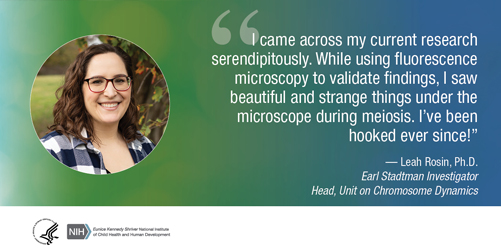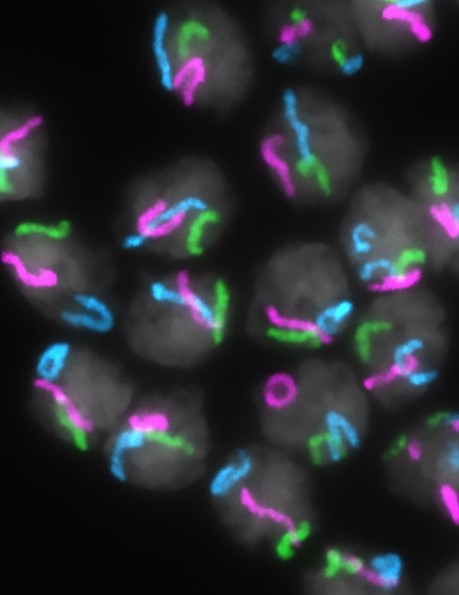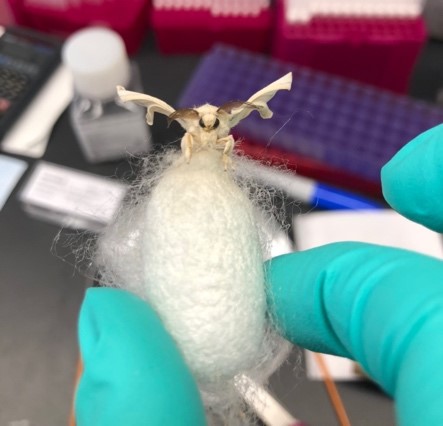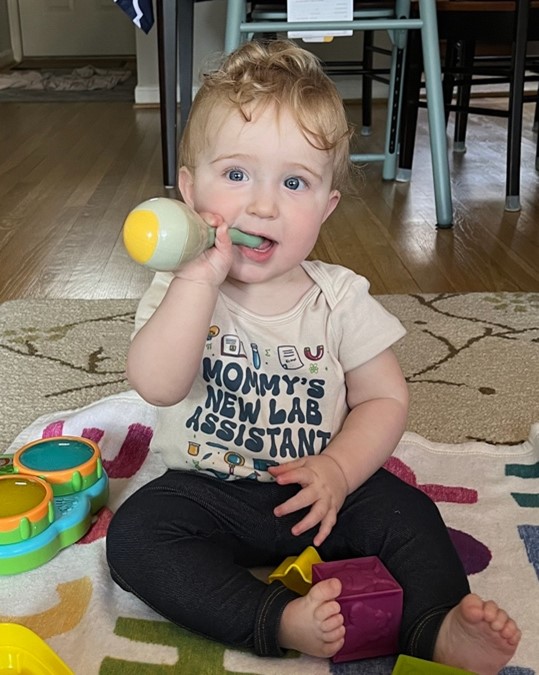What sparked your interest in research?
 I have always had some interest in science, but I didn’t consider it as a career until high school. I had an amazing biology teacher who was passionate about science, and her unit on genetics was particularly interesting. That’s when I first thought about studying genetics.
I have always had some interest in science, but I didn’t consider it as a career until high school. I had an amazing biology teacher who was passionate about science, and her unit on genetics was particularly interesting. That’s when I first thought about studying genetics.
It’s funny, I think my middle science teachers would probably be surprised to find out that I’m a scientist. I did not enjoy the types of science that were covered in middle school, like having to dissect animals or go collect samples out in the field.
At one point, I also considered clinical genetics. When I was an undergraduate at the University of Pittsburgh, I shadowed a clinical geneticist who worked with children and families. Personally, the work made me feel too sad, but I knew that I still wanted to answer genetic questions that are relevant for families. When I applied to graduate schools, I narrowed my search to schools with strong genetics programs.
How has your research focus evolved over time?
What you study during your doctorate is not as important as the mentor you choose. I didn’t appreciate this advice until I was older, and I was lucky to have chosen a great doctoral mentor, Barbara Mellone, Ph.D. 

Credit: Rosin Lab, NICHD/NIH
My current research, while still in genetics, is different from what I studied during my doctoral and postdoctoral years at the University of Connecticut 

I initially came to the NIH for a second postdoctoral fellowship, which is common nowadays, with Elissa Lei, Ph.D., at NIDDK. NIH is a unique environment with incredible resources, and Dr. Lei gave me the freedom to drive my own projects. I used an unconventional model system—the silkworm moth—initially to validate some findings, but then I saw beautiful and strange things under the microscope during meiosis—the process of cell division that creates eggs and sperm—that I had never learned about before. When I took my findings to experts in meiosis, they were also blown away by the images and encouraged me to keep going.
What was it like to transition from a postdoc to a principal investigator?
When I started my first postdoctoral training, I wasn’t sure if I wanted to run my own lab. I think this is a very common question at the beginning of any postdoc. You may struggle with imposter syndrome, or maybe you have never been given the opportunity to drive your own research questions in a truly independent manner.
While I always had a lot of freedom in the lab as a trainee, it wasn’t until I became an NIH postdoc that I had the opportunity to come up with a project entirely on my own. Once I was given this opportunity and found myself successful at it, I discovered that I eventually had more experiments that I wanted to do than I did hands. My former postdoc advisor, Eric Joyce Ph.D., told me that meant I was ready to start my own lab. Finding the right position—where you are the right candidate and the work environment is right for you—is very challenging, but I ultimately landed my dream job as an Earl Stadtman Investigator at NICHD. I was told by several people that this perseverance was probably what helped make me a great scientist in the first place.
My lab and office space have been under renovation, but we’ve been very productive in our temporary space. We’re also setting up a husbandry system for our moths, as no one else in our building uses moths as a model system, and some reagents are not readily available. Some of our tools are coming from collaborations, and others we are developing ourselves in the lab.
How is your research in moths relevant to age-related infertility in women?

Credit: Rosin Lab, NICHD/NIH
One of my lab’s main research questions is really an ancient question that still doesn’t have a clear answer. During the creation of egg or sperm cells—a specialized cell division called meiosis—homologous chromosome pairs (one copy from mom and one from dad) need to find each other for genetic recombination before the cell divides. How do these chromosomes find each other and distinguish homologs from other chromosomes? This is still one of the biggest mysteries in chromosome biology. Classical model systems like fruit flies and mice have not given us clear answers that are applicable across species. I’m hoping that employing more unconventional models, like the silkworm moth and pantry moth, will help us identify processes that are broadly conserved. Ultimately, understanding the basic mechanisms for how chromosomes are regulated during egg and sperm production could give us clues on how to help people who experience infertility due to problems with meiosis.
For women, nearly all of the first meiotic prophase (the longest phase of meiosis) happens before birth, and eggs remain in an arrested state until a person reaches their reproductive years. At this time, only one egg matures and is released during ovulation each month. The rest of the eggs remain arrested. The longer the eggs stay arrested, the more unstable the linkages between chromosomes become. My lab is trying to understand how these linkages are made and how they are maintained. If we can figure this out, we can potentially find ways to reinforce the chromosomal stability of eggs as a woman ages, or for example, when eggs are retrieved as part of in vitro fertilization.
What’s your favorite research technique or tool?
My favorite technique is a fluorescence microscopy approach to paint chromosomes, called Oligopaints 
What advice do you have for people seeking to start their own lab?
My advice is to start recruiting early, especially postdocs, because good ones are hard to find. When I was a postdoc, I started recruiting people I met at conferences. I would tell graduate students that I was going to start my own lab and that they should consider joining in the future. I kept in touch with these contacts, and I’ve recruited one postdoc this way; he’ll join my lab this summer. You may feel too stressed or busy during your own postdoctoral training to think about recruiting, but you should make time for it. If people know that you like them, that you are excited about the idea of working with them, it makes them excited about working with you, too.
What has been your experience with work-life balance?

Credit: Leah Rosin, Ph.D.
I always knew I wanted to have a family, but despite having many great women model this for me in their own lives, I still found the idea very daunting. I once had a great conversation with Jeannie Lee, M.D., Ph.D. 
Last summer, I had my first baby right before I started my lab. It’s been helpful that the only life I’ve known as a mother is also as the boss of my own lab. I’ve had to set boundaries from the beginning, such as only working certain hours because I have a baby at home. That’s not to say it hasn’t felt daunting or that I haven’t had challenges. I feel lucky that my trainees are understanding and are truly exceptional scientists. We’ve flourished in a very short period of time.
Return to Get to Know NICHD.
 BACK TO TOP
BACK TO TOP